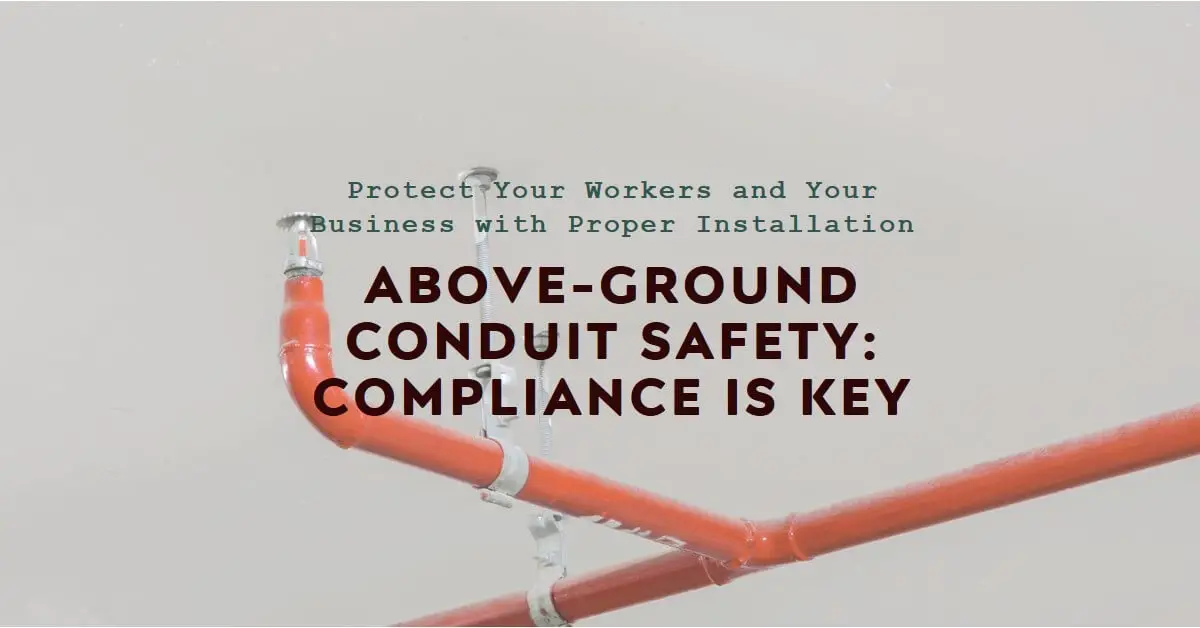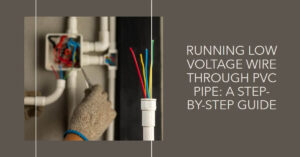Image: “Article Feature Image” by Bing, Source: [Bing Graphic Art].
Electrical conduit is an essential component for routing and protecting electrical wiring in various applications.
While the traditional approach is to install conduits within walls or underground, there may be situations where running conduit above ground becomes necessary.
Running electrical conduit above ground is allowed and can be a practical solution in certain situations. The National Electrical Code (NEC) provides guidelines for above-ground conduit installations, ensuring safety and compliance with electrical standards
This article will explore the factors to consider and the guidelines for safely and compliantly installing electrical conduits above ground.
Understanding Electrical Conduit
Electrical conduit refers to a system of tubes or channels used to enclose and protect electrical wires. It serves several purposes, including physical protection, containment of potential electrical hazards, and ease of maintenance and upgrades.
Conduits can be made of different materials such as rigid polyvinyl chloride (PVC), electrical metallic tubing (EMT), electrical nonmetallic tubing (ENT), and rigid metal conduit (RMC).
Code and Regulations
Compliance with codes and regulations is vital when installing electrical conduits.
The National Electrical Code (NEC) provides guidelines for electrical installations in the United States.
Specific articles within the NEC outline the requirements for different types of conduit. Local building codes and regulations may also have additional specifications that must be followed.
Can You Run Electrical Conduit above ground?
Running electrical conduit above ground is allowed and can be a practical solution in certain situations.
The National Electrical Code (NEC) provides guidelines for above-ground conduit installations, ensuring safety and compliance with electrical standards.
Factors such as environmental conditions, mechanical protection, voltage requirements, and aesthetics need to be considered when deciding to install conduit above ground.
By following the appropriate code regulations, selecting suitable conduit materials, and employing proper installation techniques, it is possible to run electrical conduit safely and effectively above ground.
Read also my article: White PVC Electrical Conduit: A Safe and Stylish Solution.
Factors to Consider
Before deciding to run electrical conduit above ground, several factors should be taken into account:
Environmental Conditions: Consider the exposure to environmental elements such as sunlight, extreme temperatures, moisture, and corrosive substances.
Mechanical Protection: Evaluate the potential risks of physical damage, including the impact from vehicles, equipment, or other objects.
Voltage and Current Considerations: Determine the voltage levels and current loads to ensure proper conduit sizing and adequate grounding.
Aesthetics and Accessibility: Consider the visual impact and accessibility of above-ground conduit, as it may affect the overall aesthetics of the space.
Above-Ground Conduit Installation
When installing electrical conduit above ground, the following steps should be followed:
Suitable Applications: Evaluate whether above-ground conduit is suitable for the specific application, considering factors such as building type, occupancy, and local regulations.
Conduit Types for Above-Ground Use: Different conduit materials are suitable for above-ground installations. Common options include PVC conduit, EMT conduit, ENT conduit, and RMC.
Installation Steps:
- Planning and Design: Determine the conduit route, location of junction boxes, and any necessary supports or hangers.
- Material Selection: Choose conduit materials and fittings that are approved for above-ground use and compatible with the environment.
- Routing and Support: Determine the optimal conduit routing and ensure proper support is provided at regular intervals.
- Secure Attachment Methods: Use appropriate fasteners, clamps, or straps to secure the conduit to the building structure or other supports.
- Grounding and Bonding: Follow NEC requirements for grounding and bonding the conduit to ensure safety and protection against electrical faults.
- Sealing and Weatherproofing: Apply suitable sealing materials and weatherproofing techniques to prevent water ingress and maintain the integrity of the conduit system.
Conduit Supports and Hangers: Properly sized and positioned supports and hangers should be used to ensure the stability and secure attachment of the conduit.
Junction Boxes and Fittings: Install junction boxes and fittings as required by code to facilitate connections and changes in conduit direction.
Wiring Methods and Conductors: Select the appropriate wiring methods and conductors that comply with code regulations and match the intended use of the conduit system.
Read also my article: Electrical Wire and PVC Plumbing Pipes: A Risky Combination?
Potential Issues and Solutions
When running electrical conduit above ground, certain issues may arise. Here are common problems and their corresponding solutions:
UV Exposure and Sunlight Damage: Choose UV-resistant conduit materials or apply appropriate coatings or coverings to protect against sunlight degradation.
Moisture and Water Ingress: Employ weatherproofing techniques, seal conduit connections, and use suitable conduit materials and fittings to prevent moisture penetration.
Physical Damage and Impact: Use conduit materials with adequate impact resistance and consider protective measures such as conduit guards or barriers.
Temperature Extremes: Select conduit materials rated for the expected temperature range and implement insulation or heat dissipation techniques if necessary.
Electrical Interference and Grounding: Proper grounding and bonding techniques should be employed to minimize the risk of electrical interference or electromagnetic interference (EMI).
Protection against Rodents and Pests: Incorporate measures such as conduit sleeves, rodent guards, or sealing materials to deter pests from entering the conduit system.
Maintenance and Inspection
Regular maintenance and inspections are essential for the longevity and safety of an above-ground electrical conduit system. The following practices should be implemented:
Routine Inspections: Periodically inspect the conduit system for damage, wear, or signs of deterioration. Address any issues promptly to prevent further problems.
Cleaning and Debris Removal: Keep the conduit system clean from debris, dirt, or vegetation that may impede proper operation or cause damage.
Repair and Replacement: Conduct repairs or replacements as necessary, following code requirements and using approved materials and techniques.
Conclusion
Running electrical conduit above ground can be a viable option in various scenarios, provided that the installation is done in accordance with code regulations and appropriate materials and methods are employed.
By considering factors such as environmental conditions, mechanical protection, voltage requirements, and aesthetics, one can ensure a safe and compliant conduit installation.
Want to learn more about electricity? Check my YouTube channel!
Are You An Electrical Engineer or Electrician?
Install my Free On Google Play Now! It’s 100% Free
The staff I recommend (Amazon Affiliate Links to products I believe are high quality):
- Economy 120 Volt/60Hz AC Power Source – Step-Down Voltage & Frequency Converters 1800W
- UNI-T Digital Multimeter Tester UT139C
- 50-Amp Extension Cord for RV “100ft”
- Voltage Stabilizer 110/220v
- Hair Dryer “best selling“
- TOSHIBA EM131A5C-BS Countertop Microwave Ovens
Disclaimer: This contains affiliate links to Amazon products. I may earn a commission for purchases made through these links.



